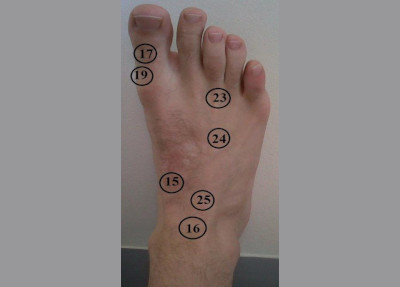Lower Leg, Foot & Ankle Pain Relief in Bondi Junction
 Relief with Chiropractic Care
Relief with Chiropractic Care
Wear and tear, injuries and more can result in pain in the lower leg. The Health Odyssey Chiropractic team can assess your condition and determine whether chiropractic care may be the right solution for you. Some of the causes of lower leg pain that we commonly see include shin splints, tibial stress fractures, intermittent claudication and compartment syndrome.
Types of Pain
- Shin Splints: Tendonitis, muscle or interosseous membrane strain and periostitis are causes of shin splints. There are two types: the anterior, which involves tibilalis anterior and extensor digitorum longus/hallicus longus muscles; and posterior, which involves flexor hallicus, longus/digitorum longus, tibialis posterior and soleus muscles. The result is pain in the front or back of the leg with a sudden onset that becomes worse when standing.
- Tibial Stress Fractures: Chronic overuse from prolonged activities such as running on hard surfaces compromises the ability of your bones to remodel or self-heal. The risk factors include forefoot varus, leg length inequality and high foot arches. It often occurs in those who are active with the first sign being tibial pain.
- Intermittent Claudication: Atherosclerosis that reduces the blood supply to the muscles causes peripheral vascular disease, often in an older patient who has leg pain and must stop and rest after walking for a few minutes. The symptoms include tightening, cramping and tiredness in the legs with possible cardiovascular risk factors.
- Compartment Syndrome: There are four compartments in the lower leg: The front, or anterior, composed of the tibial vein and artery, tibialis anterior, deep peroneal nerve and toe extensor muscles, The back or deep posterior, made up of the toe flexor muscles, tibialis posterior and posterior tibial artery and vein. The superficial posterior or back area, which involves the soleus, plantaris and gastrocnemius muscles. The lateral, which is made up of the peroneal nerve and muscles. An increase in pressure to any of these compartments affects the related structures, resulting in cramping and aching after exercise that is initially relieved by rest. Pain and numbness in the foot can also be experienced with pressure increased by exercise, fracture or trauma.



| Area of Pain | Structures | Acute Traumatic Injury | Chronic Overuse |
| 1 | Peroneus Longus and Brevis Tendons and Sural nerve | Contusion of the Structures | Peroneal Tendonitis |
| 2 | Anterior Tibiofibular ligament | Sprained ligament, damaged interosseous membrane. | Scar Tissue from previous ankle sprains |
| 3 | Anterior Talofibular ligament | Inversion ankle sprain | Scar tissue from previous ankle sprains |
| 4 | Peroneous Tertius muscle, Extensor tendons, superficial Peroneal nerve. | Contusion of the structures. | Peroneous Tertius or extensor tendonitis |
| 5 | Calcaneofibular ligament, peroneal tendons and retinaculum. | Inversion ankle sprain with possible torn ligament or retinaculum. | Snapping peroneal tendons due to weak retinaculum ligament. |
| 6 | Extensor Digitorum Brevis muscle, distal calcaneus, bifurcate ligament. | Bifurcate ligament rupture, avulsion fracture of distal calcaneus. | Strain Extensor Digitorum Brevis muscle. |
| 7 | Cuboid bone | Cuboid subluxation | Cuboid syndrome |
| 8 | Base of 5th metatarsal, Peroneus Brevis muscle insertion. | Avulsion fracture of peroneus brevis, Jones Fracture (Inversion sprain) | Iselins disease (apophysitis), insertional tendonitis. |
| 9 | Metatarsal bone shaft | Metatarsal fracture | Stress fracture |
| 10 | 5th Metatarsalphalangeal joint | Fracture of Phalange | Tailors bunion |
| 11 | Achilles tendon | Achilles tendon rupture | Achilles tendonitis |
| 12 | Subcutaneous and Retrocalcaneus bursa | Bursitis | Chronic bursitis |
| 13 | Tibialis posterior tendon, Posterior Tibial nerve. | Ruptured Tibialis Posterior tendon. | Tibialis Posterior Tendonitis, Posterior Tibial nerve compression. |
| 14 | Deltoid ligament | Eversion ankle sprain | Ligament sprain from overpronation |
| 15 | Navicular bone Tubercle | Secondary to eversion sprain, subluxation. | Subluxation, secondary navicular-tarsal coalition. |
| 16 | Tibialis Anterior tendon | Strained tendon from plantarflexion injury | Tendonitis |
| 17 | Dorsal 1st Metatarsalphalangeal joint | Turf Toe/ Sand toe due to hyperextension or hyperflexion injury to the joint capsule. | Hallux Rigidis |
| 18 | Sesamoid bones | Sesamoid fracture, Sesamoiditis | Sesamoiditis |
| 19 | Lateral aspect of 1st metatarsalphalangeal joint. | Joint capsule sprain | Gout, bunion due to Hallux Valgus. |
| 20 | Plantar Fascia | Plantar Fascia rupture | Plantar fasciitis |
| 21 | Calcaneus, fat pad | Calcaneal fracture | Fat Pad Syndrome or inflammation associated with Rheumatoid Arthritis or Reiter’s syndrome. |
| 22 | Metatarsal bone heads | Metatarsal subluxation | Morton’s Neuroma, subluxation. |
| 23 | Interdigital space | Interdigital neuritis | Interdigital neuritis |
| 24 | Metatarsal bone, extensor tendons | Metatarsal fractures, subluxations. | Stress fracture tendonitis. |
| 25 | Extensor Retinaculum, joint capsule, Talus bone. | Joint capsule sprain, talar subluxation, retinaculum sprain. | Joint capsule sprain, Talar bone subluxation, Retinaculum sprain. |
Get Relief Today
Find out more about relieving your lower leg pain Bondi Junction by contacting our clinic today!
CONTACT US

